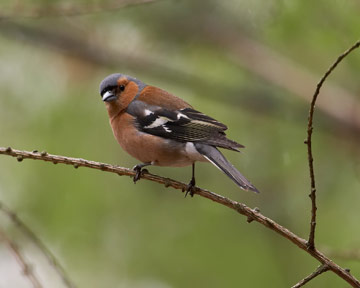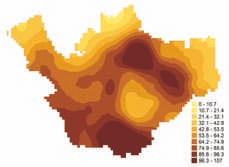
Chaffinch © Richard Steel
Chaffinch is now one of the most widespread species in the county, being found in the breeding season in 653 tetrads, 97% of the county. The ‘change’ map dramatically shows how Chaffinches have spread into the two areas from where they were missing in our First Atlas, the Mersey valley and north Wirral. In our First Atlas book it was suggested that the cause of their absence was air pollution, which inhibited the growth of epiphytic lichens that Chaffinches use to bind and camouflage the exterior of their nests. During the 1990s these lichens spread throughout the county, as shown in the maps from The Lichen Flora of Cheshire and Wirral (Fox & Guest 2003), and it seems that Chaffinches, and Long-tailed Tits, have responded.
As well as being widespread, Chaffinch is the third most abundant species in the county. The BTO BBS analysis shows that the breeding population of the county in 2004-05 was 185,450 birds (159,260-211,640), corresponding to an average of 315 birds per tetrad with confirmed or probable breeding, or 285 birds per tetrad in which the species was recorded. This equates to an average of about one pair per 2.8 ha across the entire county.
Amongst the characteristics of the fringilline finches (Chaffinch and Brambling) that separate them from the cardueline finches are their defence of breeding territories and their nestling diet, exclusively invertebrates, so in the breeding season Chaffinches behave more like an insectivore than a seed-eater. The adults’ habit of carrying food in their bill makes it easier to prove breeding than for other finches, and many birds draw attention to themselves by their territorial alarm call, only heard in the breeding season, a repeated ‘hoo-eet’, similar to the alarm call of Willow Warblers. Adult Chaffinches are long-lived birds, and they tend to have small broods, four being a typical number, with many pairs only having only one brood each year. The usual nest is in a hedge or low scrub. Breeding was confirmed in 96 tetrads by observers finding nests, with adults carrying food or a faecal sac in 176 and recently fledged young seen in 201. It was not easy to prove breeding in some of the most urban areas where Chaffinches were thinly distributed, however.

Chaffinch abundance.
Chaffinches are well adapted to suburban and garden habitats, as well as to highly fragmented woodland and hedgerows, occurring less in the open-field, arable habitats that have been affected most by agricultural intensification, so may have benefited by environmental changes from which other seed-eating passerines have suffered. Most of the reported habitat codes were farmland (37%), with 28% human sites, 26% woodland and 8% scrub.
Although mostly eating seeds outside the breeding season, Chaffinches have not been hit in the same way as other granivorous species by the agricultural changes of the past fifty years. The national population index has been stable, increasing by about 10% from 1984 to 2004, and their annual survival appears to have reduced somewhat, perhaps suggesting that the population is self-limiting and near to saturation (Siriwardena et al. 1999). [They are nesting earlier, average dates having advanced by one week in the last thirty years, probably in response to climate change (Crick & Sparks 1999).]
Sponsored by Alastair Jenkins

